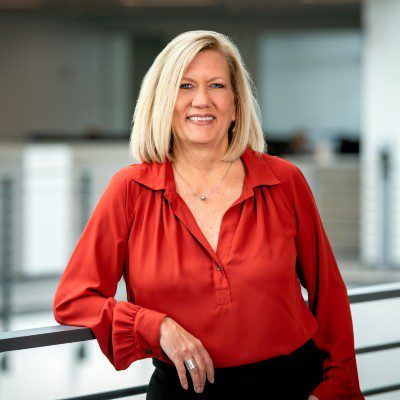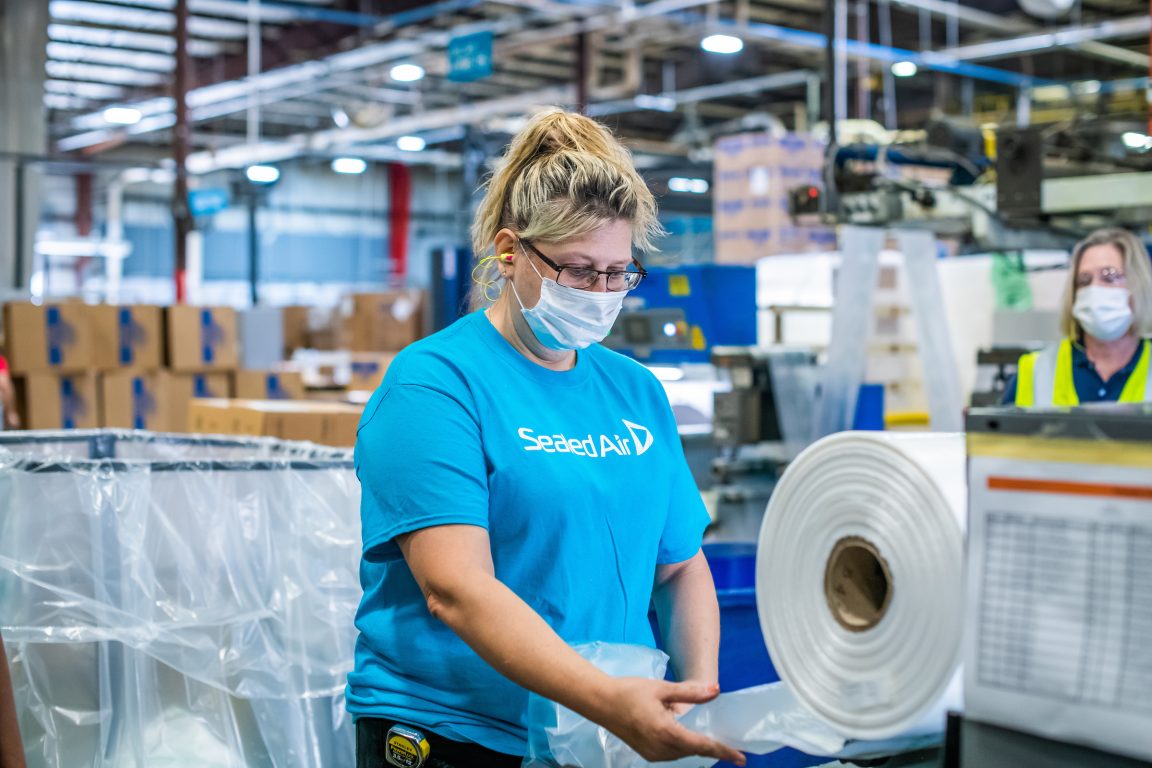Sealed Air: Tech was a “saving grace” during COVID-19
What does the future of work look like for the packaging giant?
Why You Should Care
Tech enabled companies to shift to remote work during COVID-19 and beyond.
Find out how tech enabled Sealed Air to keep all employees safe and productive during COVID-19.
How will tech help in the flexible future of work?
On the surface, packaging may not be the most ‘sexy’ industry to work in. But it is absolutely essential to the smooth running of the global economy, and it became even more essential during the COVID-19 pandemic.
For example, without packaging companies (and solutions), it would have been impossible for Pfizer, AstraZeneca, or Moderna to ship vaccines all around the world and better protect humanity against the threat of COVID-19.

Susan Edwards, CHRO, Sealed Air.
It would also be impossible for e-commerce – which we have all relied on more and more during COVID-19 – to run smoothly. Employers would have been able to order and send new laptops, screens, keyboards, and chairs to their workers, and individuals would have been unable to order grocery deliveries online when they were isolating with COVID-19.
However, this meant that packaging companies – such as Fortune 534-ranked Sealed Air – and their workers, were on the frontline of the pandemic.
“Our priority, from a people standpoint, is continuing to keep our people safe”; Susan Edwards, global vice-president and CHRO of Sealed Air, tells UNLEASH.
She emphasizes this is something Sealed Air did prior to the pandemic, “it just took a different shape when we were faced with a crisis of that level”.
Keeping employees safe during COVID-19
The first thing Sealed Air did was “determine which employees could work entirely remote, and which employees really needed to be location-based”, explains Edwards.
It turned out that 10,000 of Sealed Air’s 16,500 workers in 56 countries worked on shop floors and manufacturing facilities, and so were on the frontline. The remaining 6,500 were deemed able to work from home.
Then the HR team had to figure out “how to communicate and how to activate appropriate protocols in order… to keep them safe and protected”, but also keep the business running so Sealed Air could support its customers who “were dealing with exactly the same thing” and “seeing spikes in demand”.
So Sealed Air adopted a mantra of ‘protect the fortress’ (or its manufacturing plants and factories). “They became a lifeline and the primary support for our customers” to get “those essential products and materials” to the end consumer.
But ‘protect the fortress’ also became about safety protocols, including “continuous cleaning to make sure [workers] hadn’t been exposed to COVID-19”, and access to personal protective equipment.
But if anyone was directly or indirectly exposed, “we did aggressive contract tracing” and implemented a quarantine process where they would stay at home to keep COVID-19 away from the rest of the workforce.
Those working from home were given access to hardware, like monitors and ergonomic chairs, that allowed them to work safely and productively from home.

Credit: Sealed Air.
“Beefed up” tech to respond COVID-19
Sealed Air also held “readiness meetings” to look at whether “our technology was robust enough to support that number working remotely” – it looked at cybersecurity challenges of remote work, something that many organizations overlooked in the chaos of the pandemic.
It determined that new technology was needed to support this shift in the way of working. For instance, “we changed our video meeting technology to Microsoft Teams”. This technology was available to all employees, whether they were working at home or on the frontline. Sealed Air installed “more monitors and more video screens where we could communicate immediately with those individuals”.
Edwards explains that as a result, “everybody is now turning on their camera and seeing each other face to face”. The old technology was limited and couldn’t support that, which hindered Sealed Air’s ability to have “good virtual face-to-face meetings, forums and training sessions”.
The company also dialed up its use of its intranet – according to Edwards, “our intranet became a very, very important, even more so than before, as a resource for all our employees”. This is because it became the home for COVID-19 guidelines and other updates that the HR team needed to share in real-time.
“Our communications team were the champions of the year – they were non-stop keeping people up-to-date on what was going on and educating everyone on how to protect themselves and their families”.
Edwards and the Sealed Air leadership team were aware from the beginning that COVID-19 “completely disrupted” the lives and homes of the workers – and looked into how technology could help. “We looked at how we might be able to support them with their family obligations…along with [enabling them] to show up well for work”.
So, the packaging giant rolled out a new online global wellbeing platform in partnership with Virgin Pulse. It is available across 55 countries and in 20 languages. “We brought that in because we started to immediately hear that wellbeing was a priority, and we really needed to be able to support our employees”, as well as their families.
Central to the wellbeing app is it encourages regular movement and mental health breaks. This is important to Edwards and her team; “when we were at work on our campus, you tend to walk about 6,000 steps a day going from building to building. Then suddenly you’re going from your bedroom to your kitchen, and it is like 300 steps, instead of 6,000; sitting all day became a concern for us as well”.
Sealed Air also “beefed up” its learning and development platforms and shifted them online. “We put in place LinkedIn learning” and dialed up its broader learning management system (LMS) to make it easier to create and access content, as well as translate it into different languages and then push it out.
“Technology was a saving grace really. It allowed all of our employees across 56 countries to work collaboratively, stay connected and participate”, adds Edwards.
The future of flexible work at Sealed Air
Fast forward two years, and most of Sealed Air’s 6,500 non-location-dependent workers are still working from home. This is because of a continuing desire to ‘protect the fortress’ and focus on the needs of the business, and frontline workers.
Edwards explains that Sealed Air had been considering moving to flexible working before the pandemic – but “there was some apprehension about whether that could work, whether people would remain productive and whether it would threaten our culture”; “our culture is a very collaborative, innovative and personal culture”.
But the pandemic gave the company no choice but to embrace remote working, and showed that workers “not only remained productive, but in a lot of ways felt more productive” outside of the office.
So Sealed Air surveyed its employees in June 2020 (with the help of Qualtrics) to find out their views on the future of work. More than 90% of workers responded, and “they told us that they really want some balance [between] working from anywhere and being able to see each other in person”.
So Edwards and her team started working on a flexible working model; “it makes sense for who we are, and it supports all our values and competencies”.
In the model, employees get to decide where they want to work on Mondays and Fridays – they can choose to work in the office, or they can choose anywhere else. “It is up to them to be productive; they’ve got the technology, the tools and the hardware”, explains Edwards.
Then Tuesdays, Wednesdays, and Thursdays “are at the discretion of the people managers” – but the HR team has advised them not to be “heavy-handed” here. Rather than requiring them all to be in the office, understand individual’s preferences and “understand when on-site work is really beneficial” for collaboration.
At Sealed Air, it is crucial that the plans have employee input and that they are told in advance “so they can plan their lives” accordingly.
Of course, this approach involves a rethink of the company’s office spaces. Rather than everyone having a dedicated desk, “we’ve changed our offices to be an open hoteling environment”, this means individuals and teams can reserve desks when they are going to in the office.
Sealed Air is still monitoring the COVID-19 situation across the world, and is still encouraging its non-location-dependent employees to work from home.
Edwards notes: “We can’t wait to fully enact it because we rolled it out a year ago (January 2021), and are still waiting to put it in full motion.”
Importance of employee listening
Edwards is clear that pulse surveys were not only be used to figure out Sealed Air’s future of work; employee listening, and experience, is core to the world of work at the packaging giant.
For example, a recent voluntary survey carried out on Qualtrics focused on inclusion. “We wanted to understand [how] we start to talk about making Sealed Air a more inclusive workplace across a company that is as culturally diverse as we are”. So the company asked employees across the busy “What does inclusion mean to you?”
Edwards is very pleased with the Qualtrics solution; Sealed Air previously used BI Worldwide. Now the solution “allows us to get the analytics out very, very quickly”, “almost in real-time”.
But Sealed Air doesn’t just look at the data and take no action. HR then follows up with video calls with employees to understand the rationale behind their answers – they asked questions like what are we doing well? What more do we need to be doing?
Work from anywhere and the ‘Great Resignation’
It wouldn’t be an UNLEASH interview if we didn’t find out how Sealed Air is dealing with the ongoing ‘Great Resignation’. Edwards is clear that the company is not “seeing a problem”, “but we are, of course, seeing an impact”, particularly where there is a scarcity of professionals with the right skills for manufacturing, frontline work.
She explains that this is a struggle for all manufacturing and packaging companies in the US and Europe, “but we’ve always had a lower than average industry turnover”.
This is attributed to our “purpose, and our culture”, and now Sealed Air’s “flexible way of work”. Studies have shown that workers will quit their jobs for other companies with better flexible working options.
Another benefit of the flexible future of work at Sealed Air, according to Edwards, is it allows individuals to not only work from anywhere – employees do not have to work from the office or from home, they can choose other options like cafes or a holiday home – but also for the company to hire from anywhere.
“The beauty of learning how to work remotely is that it opened up our candidate pools for certain jobs, and our ability to no longer think about location [when hiring]”, notes Edwards. She explains that this is only the case for jobs Sealed Air has deemed to be non-location-dependent.
“Now we can think about our workforce without borders; that is one of the silver linings of remote, flexible work”, concludes Edwards.
Sign up to the UNLEASH Newsletter
Get the Editor’s picks of the week delivered straight to your inbox!

Chief Reporter
Allie is an award-winning business journalist and can be reached at alexandra@unleash.ai.
